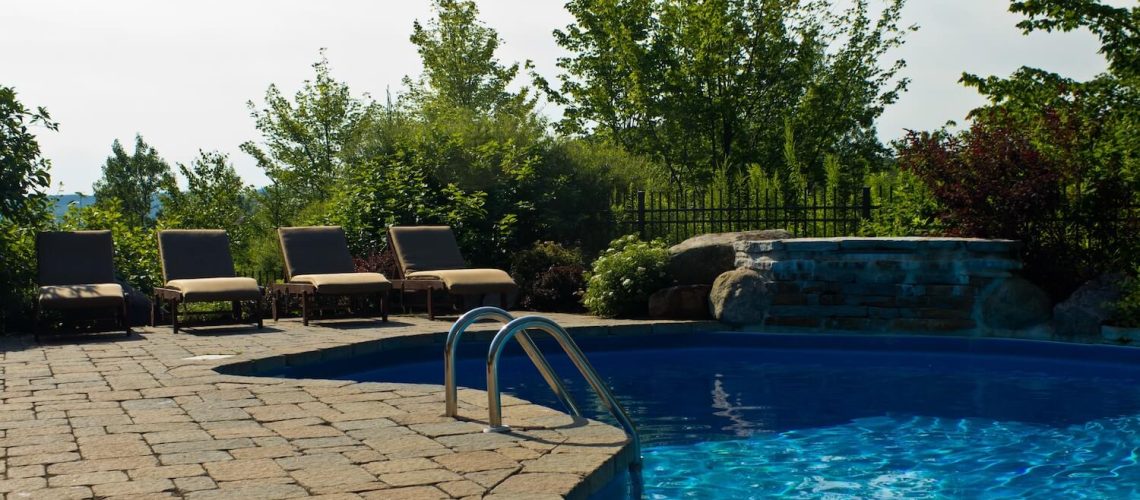A swimming pool is often the centerpiece of a backyard, a hub for relaxation, entertainment, and family gatherings. The surrounding area, known as the pool deck, plays a crucial role in the overall aesthetic and functionality of the pool area. One of the most popular and effective ways to enhance this space is through the installation of pavers. Proper paver installation not only elevates the visual appeal of your pool area but also ensures safety, durability, and ease of maintenance. In this article, we will explore the importance of proper pool paver installation and how it can transform your pool’s aesthetic.
Understanding Pool Pavers
Pool pavers are durable, flat stones made from various materials such as concrete, brick, natural stone, or porcelain. They are designed specifically for outdoor use and can withstand various weather conditions. Pool pavers come in different shapes, sizes, colors, and textures, offering homeowners a wide range of design options to suit their style preferences.
The Importance of Proper Installation
Proper installation of pool pavers is paramount for several reasons, including aesthetics, safety, durability, and maintenance.
1. Aesthetics
The visual appeal of your pool area significantly depends on the installation of pavers. Properly installed pavers can create a seamless, elegant look that complements the overall design of your backyard. Whether you prefer a modern, sleek appearance or a rustic, natural look, pavers can be arranged in various patterns to achieve the desired effect. Proper installation ensures that the pavers are evenly spaced, aligned, and level, resulting in a polished and professional appearance.
2. Safety
Safety is a critical consideration for any pool area, and proper paver installation plays a significant role in ensuring it. Uneven or improperly installed pavers can create tripping hazards, which can be particularly dangerous around a pool. Additionally, the choice of paver material and surface texture can impact slip resistance. Proper installation involves selecting pavers with appropriate slip resistance and ensuring they are securely placed to prevent movement, reducing the risk of accidents.
3. Durability
The longevity of your pool deck depends on the quality of the pavers and the installation process. Proper installation techniques, such as adequate base preparation, correct spacing, and secure edging, ensure that the pavers can withstand the test of time. Well-installed pavers are less likely to shift, crack, or develop weeds in between, maintaining their structural integrity and appearance for years to come.
4. Ease of Maintenance
A well-installed paver deck is easier to maintain than one with installation issues. Proper installation prevents problems such as water pooling, weed growth, and paver displacement. This makes routine cleaning and maintenance more straightforward, allowing you to enjoy your pool area without constant upkeep concerns.
The Installation Process
Proper paver installation is a meticulous process that involves several key steps. Each step is crucial for achieving a durable, aesthetically pleasing, and safe pool deck.
1. Planning and Design
The first step in the installation process is planning and design. This involves selecting the type of pavers, determining the layout and pattern, and calculating the required materials. It’s essential to consider factors such as the pool’s shape, the surrounding landscape, and your personal style preferences. A professional installer can help you create a design that maximizes both functionality and aesthetic appeal.
2. Excavation and Base Preparation
Proper base preparation is the foundation of a successful paver installation. The area around the pool must be excavated to the appropriate depth, removing any existing materials, debris, and vegetation. This ensures a clean slate for the paver installation.
Once the area is excavated, a base layer of crushed stone or gravel is added. This layer is compacted to create a stable foundation, preventing the pavers from shifting or sinking over time. Proper drainage considerations are also crucial at this stage to prevent water accumulation under the pavers, which can lead to erosion and instability.
3. Laying the Pavers
With the base prepared, the next step is laying the pavers. This involves carefully placing the pavers according to the chosen design and pattern. Proper spacing and alignment are essential to ensure a cohesive look and prevent uneven gaps. In some cases, pavers may need to be cut to fit around curves, corners, or other obstacles.
A key aspect of this step is ensuring that the pavers are level. A level surface not only enhances the visual appeal but also improves safety by reducing tripping hazards. The use of a level and rubber mallet can help achieve precise placement and alignment.
4. Edging and Jointing
Edging is an important step that provides structural support and prevents the pavers from shifting. Various edging materials, such as plastic, metal, or concrete, can be used to secure the perimeter of the paver area. Properly installed edging keeps the pavers in place and maintains the integrity of the design.
After the pavers are laid and edged, jointing material is applied to fill the gaps between the pavers. This material, often sand or polymeric sand, helps lock the pavers in place and prevents weed growth. Proper jointing also enhances the overall appearance by creating a seamless look.
5. Compaction and Sealing
The final steps in the installation process involve compaction and sealing. Compaction ensures that the pavers are firmly set in place, reducing the risk of shifting or settling. A plate compactor is typically used to achieve this.
Sealing is an optional but recommended step that provides additional protection for the pavers. A high-quality sealer helps prevent stains, enhances color, and protects against the elements. It also makes the pavers easier to clean and maintain, extending the lifespan of your pool deck.
Choosing the Right Paver Materials
Selecting the right paver materials is a crucial aspect of creating an aesthetically pleasing and functional pool deck. Here are some popular options:
1. Concrete Pavers
Concrete pavers are a versatile and cost-effective option. They come in various shapes, sizes, and colors, allowing for creative design possibilities. Concrete pavers are durable and can mimic the appearance of natural stone, brick, or tile.
2. Brick Pavers
Brick pavers offer a classic, timeless look that complements various architectural styles. They are known for their strength and durability, making them an excellent choice for pool decks. Brick pavers are available in different shades of red, brown, and tan, adding warmth and character to the pool area.
3. Natural Stone Pavers
Natural stone pavers, such as travertine, limestone, and slate, provide a luxurious and elegant appearance. Each stone has unique color variations and textures, creating a sophisticated and high-end look. Natural stone pavers are highly durable and can withstand harsh weather conditions.
Benefits of Professional Installation
While some homeowners may consider a DIY approach to paver installation, hiring a professional installer offers several advantages:
1. Expertise and Experience
Professional installers have the knowledge and experience to ensure proper installation techniques are followed. They understand the intricacies of base preparation, paver placement, and edging, resulting in a flawless and durable pool deck.
2. Time and Efficiency
Installing pavers can be a time-consuming process, especially for those without experience. Professionals can complete the project efficiently, allowing you to enjoy your upgraded pool area sooner.
3. Quality Assurance
A professional installation comes with quality assurance, ensuring that the pavers are installed correctly and will last for years to come. Many professional installers offer warranties on their work, providing peace of mind.
4. Access to Tools and Equipment
Professional installers have access to specialized tools and equipment necessary for a precise and efficient installation. This includes compactors, saws, and leveling tools, which may not be readily available to the average homeowner.
Maintenance Tips for Pool Pavers
To keep your pool deck looking its best, regular maintenance is essential. Here are some tips for maintaining your pool pavers:
1. Regular Cleaning
Regularly sweep and hose down the pavers to remove dirt, debris, and leaves. This prevents stains and keeps the surface clean and inviting.
2. Weed Control
Keep an eye out for weeds growing between the pavers and remove them promptly. Applying a weed inhibitor or using polymeric sand can help prevent weed growth.
3. Stain Removal
Address stains promptly to prevent them from setting in. Use a mild detergent and a brush to scrub away stains caused by food, beverages, or other substances.
4. Sealing
Consider resealing your pavers every few years to maintain their appearance and protect them from stains and weather damage. Choose a high-quality sealer appropriate for the type of pavers you have.
5. Repair and Replacement
Inspect your pavers regularly for any signs of damage or displacement. Promptly repair or replace damaged pavers to maintain the integrity and safety of the pool deck.
Conclusion
Proper paver installation is essential for elevating the aesthetic and functionality of your pool area. It enhances the visual appeal, ensures safety, improves durability, and simplifies maintenance. By following the proper installation steps and choosing the right paver materials, you can create a stunning and inviting pool deck that will be the envy of your neighborhood. Whether you opt for a DIY project or hire a professional installer, investing in proper paver installation is a decision that will pay off in both beauty and longevity. So, take the plunge and transform your pool area into a stylish oasis with the right pavers and installation techniques.

